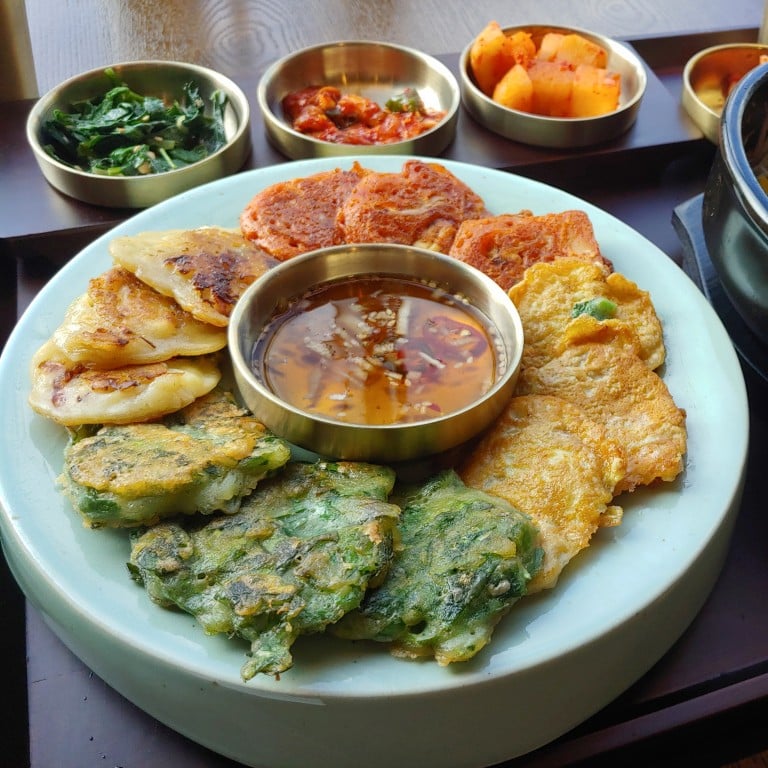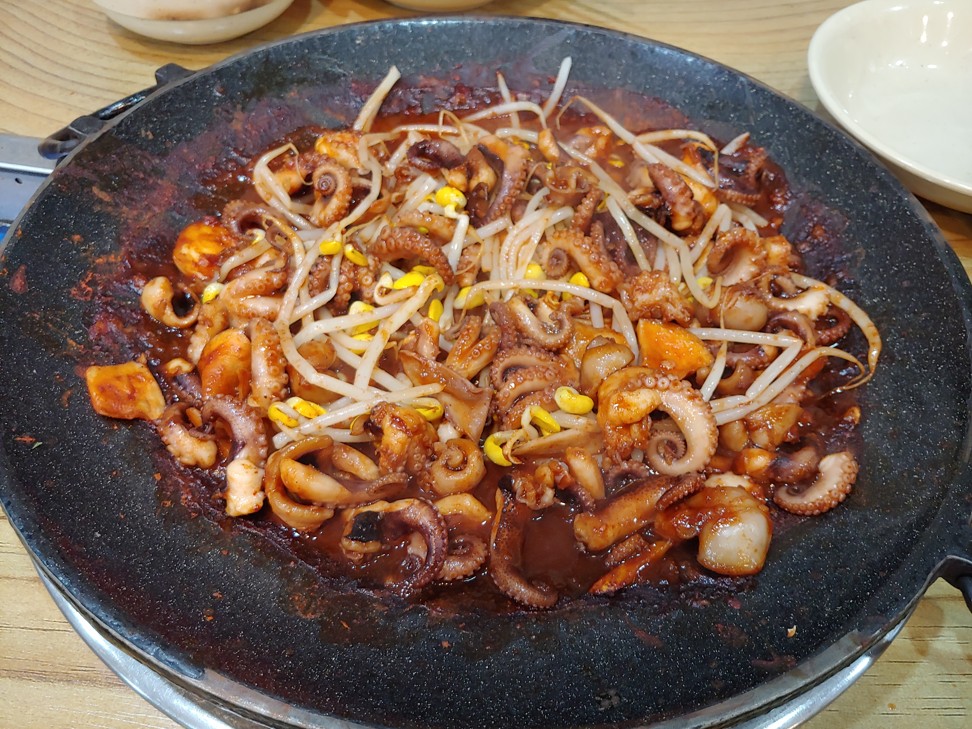7 top places to eat like a local in Seoul – try stand-up BBQ and Korean specialities like jjukkumi, siraegi, sujebi and patjuk

From fine dining to down-to-earth eateries, here are seven places to eat like a local in Seoul.
1. Korean Folk Village Market Pub
The Korean Folk Village Market Pub opened on October 30 inside the Annyeong Insadong building, a recently built multistorey culture complex similar to the neighbouring Ssamzigil in Insa-dong, a traditional street frequented by tourists. This “market pub”, which is a culinary branch of the existing Korean Folk Village located on the outskirts of Seoul, serves Korean traditional food with modern plating, in a spacious and neatly designed environment.
The modeum jeon (assorted pancakes) is worth a try along with the other jeons (pancakes), and the jangteo sogogi-gukbap (market beef soup) is also a great addition to the pancakes. Koreans like to eat jeon with makgeolli (rice wine) or dongdongju (another variety of rice wine) so give it a try. They also serve ihwaju, a yogurt-type makgeolli that you eat with a spoon, which is not easily found in other restaurants.
4F, 49 Insadong-gil, Jongno-gu, Seoul
Tel. 02-6954-2858
2. Sudam
Looking for a formal meal in fine-dining style but with an affordable price? Sudam is the answer. The Samseong-dong based restaurant serves a variety of dishes in small portions much like Spanish tapas, but instead they come one after another – like French fine dining. The most basic option for lunch is a 12-course meal for one person, but don’t gasp – the price is amazingly cheap considering the wide selection.
This place is a recent discovery of mine, but after stumbling upon it with colleagues it’s become my go-to place for treating foreign visitors in Seoul to a full table of delicacies. The restaurant probably isn’t known to foreigners as there is no English menu, but if in doubt just opt for the basic lunch set.
418 Bongeunsa-ro, Gangnam-gu, Seoul
Tel. 02-558-4900
3. Siraeok
In Korea, there are many restaurants that specialise in one type of food and Siraeok is one of them. The local franchise headquartered in Seocho-dong serves dishes using siraegi as its main ingredient, which is served with either fish or meat. Siraegi is dried radish leaves, which have been separated from the radish that is usually used for making kimchi. Koreans tend to use all parts of ingredients – whether it is poultry or vegetables – and siraegi is no exception.
Siraegi is a valuable ingredient cooked as soup, as banchan (side dish) or as a speciality of its own. The signature dish at Siraeok is the Siraeok Jungsik (meal) which consists of siraegi and mackerel marinated and boiled down to a soaky, moist state. They are served with rice cooked with siraegi and siraegi doenjang guk (soybean soup) along with side dishes.
330 Seochodae-ro, Seocho-gu, Seoul
Tel. 02-522-9977
4. Sinchon Seo Seo Galbi
Seoul is home to a plethora of barbecue places, but if you want to feel the life of an average office worker in Seoul, visit the Sinchon Seo Seo Galbi in Bukchang-dong, an office area full of local restaurants. The name is not to be mistaken with the neighbourhood in Seoul called Sinchon, as the restaurant is not located in that region.
“Seo Seo Galbi” literally translates to “stand-up barbecue” which originated from the tradition of taxi drivers eating galbi (barbecued beef) standing up because they didn’t have time to dine. The term is used popularly by many restaurants these days so don’t be surprised when you see the same name everywhere. Also, despite the name, most of these restaurants are sit-down. At the Bukchang-dong eatery, there is only one type of meat available: marinated beef. Dip it into their signature sauce and pair it with soju, and you’ll be no different a typical Seoulite after work.
25 Sejongdae-ro 12-gil, Jung-gu, Seoul
Tel. 02-777-5592
5. Yongdudong Jjuggumi
If you’re daring enough to try one of the spiciest Korean foods, take a trip to Yongdudong Jjuggumi located in Yongdu-dong, or any of the other restaurants serving similar jjuggumi (or jjukkumi) baby octopus dishes on that street. Na Jung-soon Halmae (Grandma’s) Jjuggumi is also a popular haunt among foodies. At these restaurants you’ll find locals pairing soju or beer with the sizzling jjuggumi served on a large black pan.

At Yongdudong Jjuggumi, the octopus comes simply with mushrooms and bean sprouts with an additional bowl of curry to dip the jjuggumi in for those who want to alleviate the spiciness. Cheese and other toppings can be added as extras. Just be aware that even the less spicy version will still burn your mouth. Only those bold enough to challenge themselves should dare pay this place a visit.
10 Muhak-ro 36-gil, Dongdaemun-gu, Seoul
Tel. 02-925-3127
6. Samcheongdong Soojebi

This humble restaurant, in the middle of the gentrified street of Samcheong-dong, remains a locals’ go-to place for sujebi for over 30 years. Sujebi is a hot soup filled with hand-pulled pieces of small dough – a flatter, thinner version of the Italian gnocchi. The broth is usually made with anchovies and clams and has a clean, refreshing taste. The sujebi in this restaurant is served in a traditional pot and is meant to be shared among companions.
Their gamja jeon (potato pancake) is a must-try, as the jeon is made of ground potatoes without any additional ingredients and has a thick chewy texture. Although the restaurant is listed in the Michelin Guide, it still seems to be frequented only by locals, and foreigners are hardly ever spotted.
101-1 Samcheong-ro, Jongno-gu, Seoul
Tel. 02-735-2965
7. Second Best in Seoul
When you’re in Samcheong-dong, hop over to Seoulseo Duljjaero Jalhaneun Jip which literally translates to the “Second Best (Place) in Seoul”. The place is reputed for its signature red bean paste porridge called patjuk, cooked in the traditional style, like the ones Korean grandmothers grew up eating. The old lady sitting at the counter is the founder and owner, and she makes sure all the porridge is done just right every day. The name “second best” was to spark a conversation with guests, she says. The patjuk served here comes in small portions – perfect as a snack – and is sprinkled with chestnuts, ginkgo fruit and mochi. The place opened in 1976 and was certified by the Seoul Metropolitan Government as “Seoul Future Heritage” in 2014.
124 Samcheong-ro, Jongno-gu, Seoul
Tel. 02-734-5302
Want more stories like this? Sign up here. Follow STYLE on Facebook, Instagram, YouTube and Twitter .

Ever tried Seoul’s seo seo galbi (Korean stand-up barbecue)? How about jjukkumi (baby octopus), patjuk (red bean porridge) or siraegi (dried radish leaves)? We’ve got a foodie itinerary for your next trip to the Korean capital